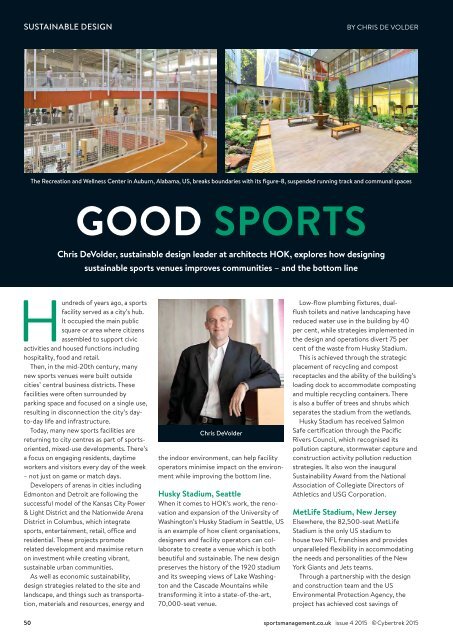EDDIE IZZARD
SM_issue4_2015
SM_issue4_2015
Create successful ePaper yourself
Turn your PDF publications into a flip-book with our unique Google optimized e-Paper software.
SUSTAINABLE DESIGN<br />
BY CHRIS DE VOLDER<br />
The Recreation and Wellness Center in Auburn, Alabama, US, breaks boundaries with its figure-8, suspended running track and communal spaces<br />
GOOD SPORTS<br />
Chris DeVolder, sustainable design leader at architects HOK, explores how designing<br />
sustainable sports venues improves communities – and the bottom line<br />
Hundreds of years ago, a sports<br />
facility served as a city’s hub.<br />
It occupied the main public<br />
square or area where citizens<br />
assembled to support civic<br />
activities and housed functions including<br />
hospitality, food and retail.<br />
Then, in the mid-20th century, many<br />
new sports venues were built outside<br />
cities’ central business districts. These<br />
facilities were often surrounded by<br />
parking space and focused on a single use,<br />
resulting in disconnection the city’s dayto-day<br />
life and infrastructure.<br />
Today, many new sports facilities are<br />
returning to city centres as part of sportsoriented,<br />
mixed-use developments. There’s<br />
a focus on engaging residents, daytime<br />
workers and visitors every day of the week<br />
– not just on game or match days.<br />
Developers of arenas in cities including<br />
Edmonton and Detroit are following the<br />
successful model of the Kansas City Power<br />
& Light District and the Nationwide Arena<br />
District in Columbus, which integrate<br />
sports, entertainment, retail, office and<br />
residential. These projects promote<br />
related development and maximise return<br />
on investment while creating vibrant,<br />
sustainable urban communities.<br />
As well as economic sustainability,<br />
design strategies related to the site and<br />
landscape, and things such as transportation,<br />
materials and resources, energy and<br />
Chris DeVolder<br />
the indoor environment, can help facility<br />
operators minimise impact on the environment<br />
while improving the bottom line.<br />
Husky Stadium, Seattle<br />
When it comes to HOK’s work, the renovation<br />
and expansion of the University of<br />
Washington’s Husky Stadium in Seattle, US<br />
is an example of how client organisations,<br />
designers and facility operators can collaborate<br />
to create a venue which is both<br />
beautiful and sustainable. The new design<br />
preserves the history of the 1920 stadium<br />
and its sweeping views of Lake Washington<br />
and the Cascade Mountains while<br />
transforming it into a state-of-the-art,<br />
70,000-seat venue.<br />
Low-flow plumbing fixtures, dualflush<br />
toilets and native landscaping have<br />
reduced water use in the building by 40<br />
per cent, while strategies implemented in<br />
the design and operations divert 75 per<br />
cent of the waste from Husky Stadium.<br />
This is achieved through the strategic<br />
placement of recycling and compost<br />
receptacles and the ability of the building’s<br />
loading dock to accommodate composting<br />
and multiple recycling containers. There<br />
is also a buffer of trees and shrubs which<br />
separates the stadium from the wetlands.<br />
Husky Stadium has received Salmon<br />
Safe certification through the Pacific<br />
Rivers Council, which recognised its<br />
pollution capture, stormwater capture and<br />
construction activity pollution reduction<br />
strategies. It also won the inaugural<br />
Sustainability Award from the National<br />
Association of Collegiate Directors of<br />
Athletics and USG Corporation.<br />
MetLife Stadium, New Jersey<br />
Elsewhere, the 82,500-seat MetLife<br />
Stadium is the only US stadium to<br />
house two NFL franchises and provides<br />
unparalleled flexibility in accommodating<br />
the needs and personalities of the New<br />
York Giants and Jets teams.<br />
Through a partnership with the design<br />
and construction team and the US<br />
Environmental Protection Agency, the<br />
project has achieved cost savings of<br />
50<br />
sportsmanagement.co.uk issue 4 2015 © Cybertrek 2015


